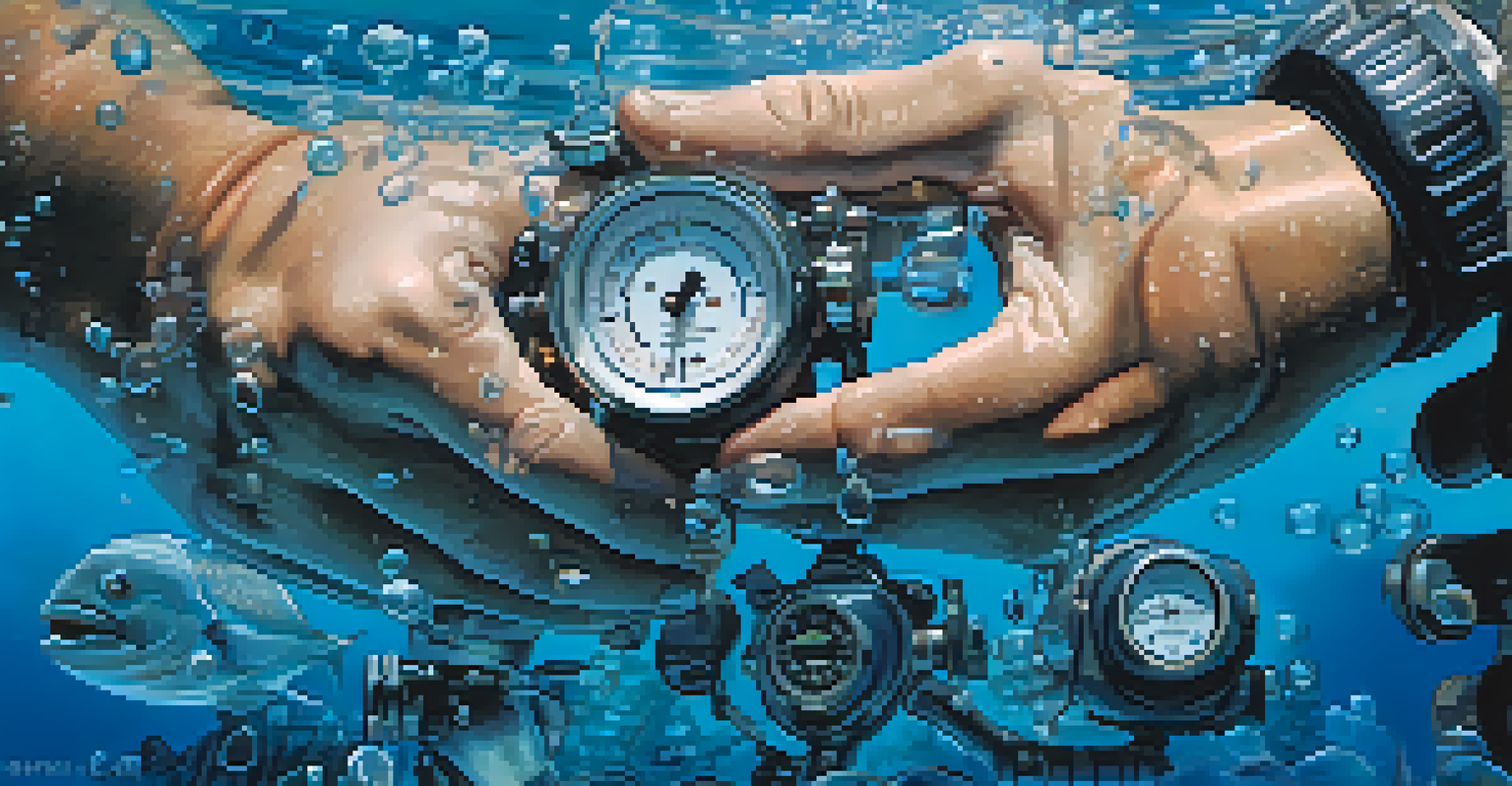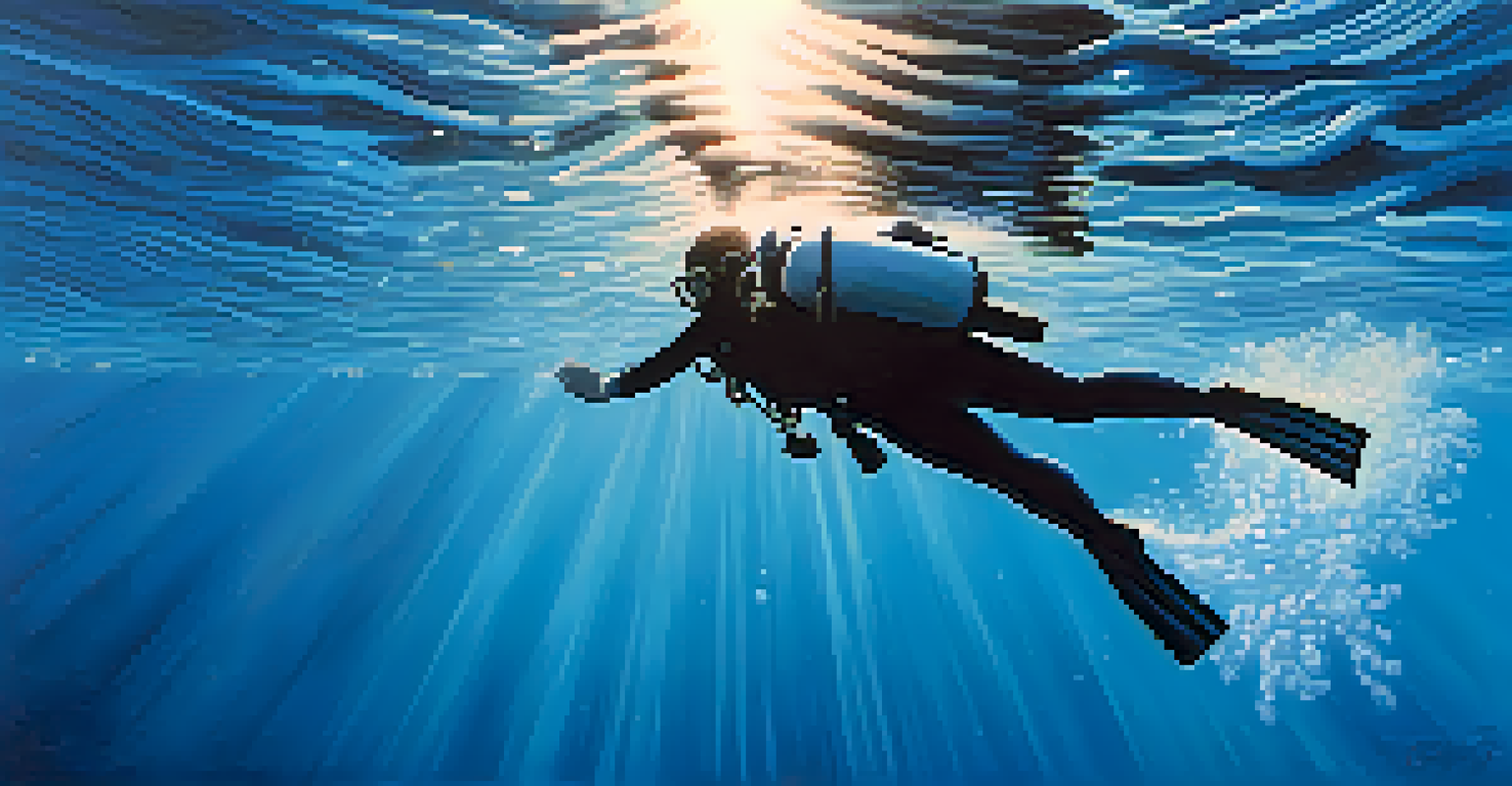Scuba Diving Safety Tips for Exploring India’s Underwater World

Understand the Local Diving Conditions Before You Go
Before you plunge into the vibrant underwater world of India, it's crucial to understand the local diving conditions. Each region, from the Andaman Islands to Goa, has its own unique underwater environment, influenced by tides, currents, and seasonal changes. Familiarizing yourself with these factors can make a significant difference in your diving experience.
The sea, once it casts its spell, holds one in its net of wonder forever.
Researching the best times to dive in specific areas will help you avoid potential hazards. For instance, some regions may be best explored during the dry season, while others may offer stunning visibility after the monsoon. Diving during unfavorable conditions increases risks, so always check local reports and consult experienced divers or dive shops.
Moreover, consider the specific marine life you might encounter in different locations. Understanding the habits and habitats of local species not only enhances your experience but also prepares you for any unexpected encounters. Knowledge truly is power when it comes to diving!
Always Dive with a Certified Dive Instructor or Buddy
Diving solo can be tempting, especially when exploring beautiful spots, but it’s always safer to dive with a certified instructor or a buddy. A qualified dive instructor is not only experienced in local conditions but can also provide invaluable knowledge about the underwater environment, ensuring a safer experience. They can guide you through the best practices and help with any unforeseen issues.

Having a buddy by your side serves as a safety net, allowing you to look out for each other. In case of emergencies, such as equipment failure or a sudden health issue, having someone nearby can make all the difference. Plus, diving with a buddy adds to the fun, as you can share your underwater discoveries together!
Understand Local Diving Conditions
Researching local tides, currents, and seasonal changes is essential for a safe and enjoyable diving experience.
Before heading out, ensure that both you and your buddy are familiar with each other’s skills and comfort levels in the water. Establishing clear communication signals and diving plans enhances safety, making your adventure enjoyable and worry-free.
Check Your Equipment Thoroughly Before Your Dive
Your diving equipment is your lifeline underwater, so checking it thoroughly before each dive is non-negotiable. Start with the basics: ensure your mask, fins, and wetsuit fit properly, as comfort is key when you're submerged. Then, move on to your tank, regulator, and buoyancy control device (BCD); these are crucial for a safe dive.
Diving is an adventure that will take you to places you never knew existed, where the only limit is your own comfort and safety.
It’s a good practice to perform a pre-dive safety check with your buddy. This includes testing your equipment and discussing emergency procedures. This collaborative approach not only fosters teamwork but also ensures that both you and your buddy are confident in your gear’s functionality.
Remember, if something feels off with your equipment during the check, don’t hesitate to seek assistance from a professional. A small issue can escalate quickly underwater, so addressing it beforehand can prevent potential dangers and ensure a smoother dive.
Monitor Your Air Supply and Dive Time Carefully
While exploring the mesmerizing underwater landscapes, it’s easy to lose track of time and air supply. This is why monitoring your air pressure and dive time is vital. Most dive watches or computers have features specifically designed to help you keep track, so make sure to familiarize yourself with your gear before diving.
As a general rule of thumb, plan to ascend with at least 500 psi left in your tank, allowing for a safe ascent and any unexpected delays. Setting a personal goal for your dive time can help manage your excitement and prevent you from staying deeper than planned, which can lead to risks like decompression sickness.
Always Dive with a Buddy
Diving with a certified instructor or buddy enhances safety and enriches the overall experience.
Staying within your limits not only ensures a safer dive but also allows you to enjoy the underwater beauty without the anxiety of running low on air. Always respect the ocean's depths and your body's limits for a fulfilling diving experience.
Ascend Slowly and Perform Safety Stops
Ascending from a dive is as critical as the dive itself. To prevent decompression sickness, it's essential to ascend slowly, ideally at a rate of no more than 30 feet (10 meters) per minute. This gradual ascent allows your body to release the nitrogen it has absorbed during the dive safely.
In addition to a slow ascent, performing safety stops at about 15 feet (5 meters) for 3-5 minutes can add an extra layer of safety. This pause helps your body adjust and further reduces the risk of decompression sickness. It’s a good time to reflect on the dive, share experiences with your buddy, and enjoy the surrounding marine life.
Remember, safety stops are not just a recommendation; they are a crucial part of safe diving practices. Make it a habit to incorporate them into your diving routine, ensuring every adventure is both memorable and safe.
Stay Calm and Know How to Handle Emergencies
Diving can sometimes be unpredictable, so knowing how to stay calm and handle emergencies is paramount. Panic can cloud your judgment, making situations worse. Practice deep, controlled breathing to manage any anxiety and focus on resolving the issue at hand.
Familiarize yourself with common diving emergencies, such as equipment failure, getting separated from your buddy, or encountering marine life. Understanding the appropriate responses to these situations can help you react calmly and effectively. Consider taking a refresher course on emergency procedures to keep your skills sharp.
Respect Marine Life and Environment
Observing marine life from a distance and practicing buoyancy control preserves delicate ecosystems while diving.
Lastly, remember that it’s okay to abort a dive if conditions become unsafe or if you’re feeling unwell. Your safety always comes first, and there will always be another opportunity to dive. Prioritizing safety not only protects you but also sets a positive example for fellow divers.
Respect Marine Life and the Environment
While exploring India's stunning underwater world, it's essential to respect marine life and the environment. Always observe marine creatures from a distance; approaching too closely can stress them out or even provoke defensive behavior. Remember, you're a visitor in their home, and the best way to enjoy their beauty is to appreciate it from afar.
Avoid touching or stepping on coral reefs, as they are delicate ecosystems that take years to grow. Even accidental contact can cause damage, so practicing buoyancy control is vital. Use a reef hook if necessary to stabilize yourself without disturbing the environment.

Finally, consider participating in local conservation efforts or clean-up dives. Not only does this help protect the marine environment, but it also enriches your diving experience, allowing you to connect with fellow divers who share your passion for preserving our oceans.